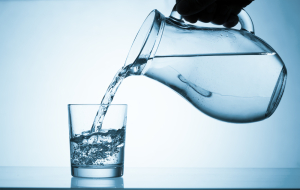Diabetes Insipidus
Introduction
Diabetes insipidus (DI) was termed “diabetes” long before all of the hormones that play a role were known. Like with diabetes mellitus the clinical presentation consists of a lot of fluid intake and urination, but there are different reasons for his. There are two types of diabetes insipidus (DI), central DI and nephrogenic DI.
The central DI can be due to a host of causes such as a basal skull fracture, tumors or inborn or acquired abnormalities that cause a disruption of vasopressin (= anti-diuretic hormone) production in the hypothalamus, a central part of the brain. The nerve cells that produce vasopressin in the hypothalamus have long tentacles that reach into the back part of the pituitary gland (posterior lobe). There the vasopressin is stored until the body needs it. When the blood gets too thick from water that was lost through the kidney, the osmolality (a measure of soluble substances) in the blood goes above a critical value, which triggers release of vasopressin into the blood stream. This in turn will be registered in specialized kidney cells near the filtering mechanism where special receptors will now signal that water needs to be reabsorbed at a faster rate. Normally this is a very efficient mechanism, which regulates itself automatically. However, with central DI there is no vasopressin that arrives at the level of the kidney.
With nephrogenic DI there are too few or no receptors in the kidney that could respond to the normally produced vasopressin.
Both of these conditions lead to polydipsia (too much drinking of fluids) and polyuria (too much urinating). However, as we will see later central DI will respond to vasopressin by normalizing polydipsia and polyuria, whereas with nephrogenic DI vasopressin will not respond to vasopressin regarding the symptoms.
There is one other condition, called compulsive water drinking (or psychogenic water drinking), where the person has emotional problems and keeps on drinking large quantities of water. A water deprivation test can be utilized to distinguish this from the other conditions.
References:
1. MT Kailasam et al. J Hypertens 2000 Nov 18(11): 1611-1620.
2. G Chinetti et al. Inflamm Res 2000 Oct 49(10): 497-505.
3. St. Paul’s 46th Annual Cont. Med. Educ. Course for Prim. Phys., Nov. 14-17, 2000. Dr. David Thompson, Div. of Endocr., Vancouver Hosp. and UBC.
4. B J Goldstein Int J Int Pract 2000 Jun 54(5): 333- 337.
5. M Maghnie et al. N Engl J Med 2000 Oct 5;343(14): 998-1007.
6. E Albertazzi et al. J Am Soc Nephrol 2000 Jun 11(6):1033-1043.
7. M Funk et al. American Journal of Emergency Medicine Vol.19,No.6, Oct.2001, W. B. Saunders Company
8. Ferri: Ferri’s Clinical Advisor: Instant Diagnosis and Treatment, 2004 ed., Copyright © 2004 Mosby, Inc.
9. Rakel: Conn’s Current Therapy 2004, 56th ed., Copyright © 2004 Elsevier
10. Coen D.A. Stehouwer et al. : “Increased Urinary Albumin Excretion, Endothelial Dysfunction, and Chronic Low-Grade Inflammation in Type 2 Diabetes –
Progressive, Interrelated, and Independently Associated With Risk of Death. DIABETES, VOL. 51, APRIL 2002: 1157-1165.
11. Melmed: Williams Textbook of Endocrinology, 12th ed., copyright 2011 Saunders, An Imprint of Elsevier . Chapter 31: “Type 2 Diabetes Mellitus”.







